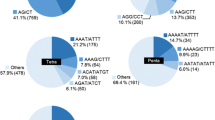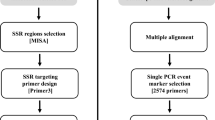Abstract
The application of simple sequence repeat (SSR) genotyping for the characterization of genetic variation in crop plants has been hindered by ready access to useful primer pairs and potentially limited conservation of the repeat sequences among related species. In this phase of work, we report on the identification and characterization of SSRs that are conserved in Brassica napus L. (rapeseed) and its putative progenitors, B. oleracea L. (cabbage, and related vegetable types) and B. rapa (vegetable and oil types). Approximately 140 clones from a size-fractionated genomic library of B. napus were sequenced, and primer pairs were designed for 21 dinucleotide SSRs. Seventeen primer pairs amplified products in the three species and, among these, 13 detected variation between and within species. Unlike findings on SSR information content in human, no relationship could be established between the number of tandem repeats within the target sequence and heterozygosity. All primer pairs have been designed to work under identical amplification conditions; therefore, single-reaction, multiplex polymerase chain reaction (PCR) with these SSRs is possible. Once moderate numbers of primer pairs are accessible to the user community, SSR genotyping may provide a useful method for the characterization, conservation, and utilization of agricultural crop diversity.
Similar content being viewed by others
References
Akkaya MA, Bhagwat AA, Cregan PB (1992) Length polymorphisms of simple sequence repeat DNA in soybean. Genetics 132:1131–1139
Altschul SF, Gish W, Miller W, Myers EW, Lipman DJ (1990) Basic local alignment search tool. J Mol Biol 215:403–410
Beckman JS, Soller M (1990) Toward a unified approach to genetic mapping of eukaryotes based on sequence tagged microsatellite sites. Bio/Technology 8:930–932
Colosi JC, Schaal BA (1993) Tissue grinding with ball bearings and vortex mixer for DNA extraction. Nucleic Acids Res 21:1051–1052
Condit R, Hubbell SP (1991) Abundance and sequence of 2-base repeat regions in tropical tree genomes. Genome 34:66–71
Cregan, PB (1992) Simple sequence repeat DNA length polymorphisms. Probe 2:18–22
Dumais MM, Nochumson S (1987) Small DNA fragment separation and M13 cloning directly in remelted NuSieve GTG agarose gels. BioTechniques 5:62–67
Estoup A, Garnery L, Solignac M, Cornuet JM (1995) Microsatellite variation in Honey Bee (Apis Mallifera L.) populations: Hierarchical genetic structure and test of the infinite allele and stepwise mutation models. Genetics 140:679–695
Hamada H, Petrino, MC, Takugana T (1982) A novel repeated element with Z-DNA forming potential is widely found in diverse eukaryotic genomes. Proc Natl Acad Sci USA 79:6465–6469
Johansson M, Ellegren H, Andersson L (1992) Cloning and characterization of highly polymorphic porcine microsatellites. J Hered 83:196–198
Kresovich S, Lamboy WF, Szewc-McFadden AK, McFerson JR, Forsline PL (1993) Molecular diagnostics and plant genetic resources conservation. AgBiotech News Inf 5:555–558
Kresovich S, Szewc-McFadden AK, Bliek SM, McFerson JR (1995) Abundance and characterization of simple sequence repeats (SSR) loci isolated from a size-fractionated genomic library of Brassica napus L. (rapeseed). Theor Appl Genet 91:206–211
Lagercrantz U, Ellegren H, Andersson L (1993) The abundance of various polymorphic microsatellite motifs differs between plants and vertebrates. Nucleic Acids Res 21:1111–1115
Mellersh C, Sampson J (1993) Simplifying detection of microsatellite length polymorphisms. BioTechniques 15:582–584
Olsen M, Hood L, Cantor C, Botstein D (1989) A common language for physical mapping of the human genome. Science 245:1434–1435
Poulsen GB, Kahl G, Weising K (1993) Abundance and polymorphism of simple repetitive DNA sequences in Brassica napus L. Theor Appl Genet 85:994–1000
Queller DC, Strassmann JE, Hughes CE (1993) Microsatellites and kinship. Trends Ecol Evol 8:285–288
Rafalski JA, Tingey SV (1993) Genetic diagnostics in plant breeding: RAPDs, microsatellites and machines. Trends Genet 9:275–279
Rongwen J, Akkaya MS, Bhagwat AA, Lavi U, Cregan PB (1995) The use of microsatellite DNA markers for soybean genotype identification. Theor Appl Genet 90:43–48
Saghai Maroof MA, Biyashev RM, Yang GP, Zhang Q, Allard RW (1994) Extraordinarily polymorphic microsatellite DNA in barley: Species diversity, chromosomal locations, and population dynamics. Proc Natl Acad Sci USA 91:5466–5470
Sambrook J, Fritsch EF, Maniatis T (1989) Molecular cloning: A laboratory manual, 2nd edn. Cold Spring Harbor Laboratory Press, Cold Spring Harbor, N.Y.
Senior ML, Heun M (1993) Mapping maize microsatellites and polymerase chain reaction confirmation of the targeted repeats using a CT primer. Genome 36:884–889
Tautz D (1989) Hypervariability of simple sequence as a general source for polymorphic DNA markers. Nucleic Acids Res 17:6463–6471
Tautz D, Renz M (1984) Simple sequences are ubiquitous repetitive components of eukaryotic genomes. Nucleic Acids Res 12:4127–4138
Thomas MR, Scott NS (1993) Microsatellite repeats in grapevine reveal DNA polymorphisms when analyzed as sequence-tagged sites (STSs). Theor Appl Genet 86:985–990
Weber JL (1990) Informativeness of human (dC-dA)n (dG-dT)n polymorphisms. Genomics 7:524–530
Weber JL, May PE (1989) Abundant class of human DNA polymorphisms which can be typed using the polymerase chain reaction. Am J Hum Genet 44:388–396
Zhao X, Kochert GD (1993) Phylogenetic distribution and genetic mapping of a (GGC)n microsatellite from rice (Oryza sativa L.). Plant Mol Bio 21:607–614
Ziegle JS, Su Y, Corcoran KP, Nie L, Mayrand PE, Hoff LB, McBride LJ, Kronick MN, Diehl SR (1992) Application of automated DNA sizing technology for genotyping microsatellite loci. Genomics 14:1026–1031
Author information
Authors and Affiliations
Additional information
Communicated by G. E. Hart
Rights and permissions
About this article
Cite this article
Szewc-McFadden, A.K., Kresovich, S., Bliek, S.M. et al. Identification of polymorphic, conserved simple sequence repeats (SSRs) in cultivated Brassica species. Theoret. Appl. Genetics 93, 534–538 (1996). https://doi.org/10.1007/BF00417944
Received:
Accepted:
Issue Date:
DOI: https://doi.org/10.1007/BF00417944




